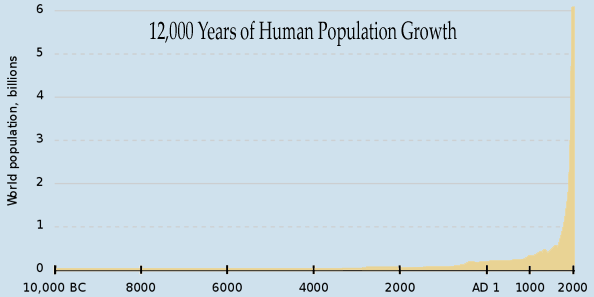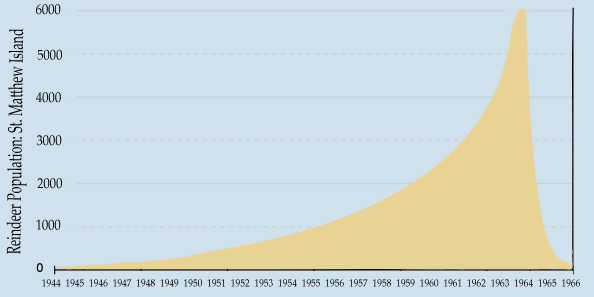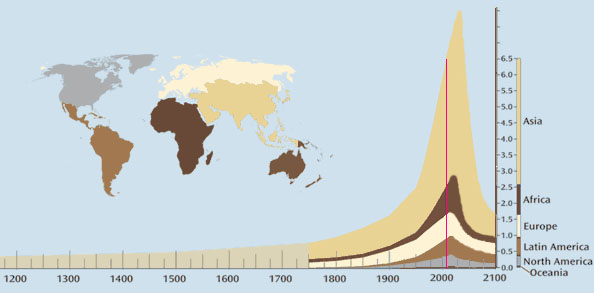Understand the Exponential Function
A classic introduction to the exponential function involves yeast added to a culture media. So let's imagine a spherical vat with a diameter of 86 feet (26.23 meters) containing 2,496,205 gallons (9,449,166 liters) of grape juice. A single yeast cell is added (brewer's yeast average 3.5 microns, so if a yeast were the size of a human [1.7 m], the vat would be the size of Earth). Yeast can grow and divide every hour, so at the end of the first hour there are two yeast. At the end of the second, there are four yeast. At the end of the third hour there are eight, then 16, 32, 64, and so on.
Growth continues, hour after hour, with each hour, from the yeast's point of view, resembling the last—each generation ends up with twice as many neighbors. As the alcohol level in the vat slowly increases, other organisms living in the vat begin to die off. Things just keep getting better and better for the yeast until only yeast remain alive. Everything continues to go along swimmingly until the 43rd hour when the yeast population reaches 10 trillion, and the vat is 'full' of yeast. The level of alcohol has finally become so toxic that even the yeast can't survive, and by the end of the 43rd hour all the yeast are dead (or cease to function).
Now the question, dear student, your final exam so to speak, is this: In what hour was the vat half full?
The answer, as Deep Thought has already computed, is 42.
So what? Ah, well, look around you. You might be doing just fine, but how many of your fellow 7 billion humans can say the same? Given the increasing difficulties of providing, however inadequately, for the current 7 billion people, do you think Earth can support 14 billion people? If you do, then you believe we are living at the start of the 42nd hour.
Maybe you're wildly optimistic and think that ever new and clever solutions will be forthcoming so that surely 28 billion people is not too many to be provided for. If so, then you believe we're living at the beginning of the 41st hour. Well, bad news for those who would like to believe so;
the consensus among those who think about these things (scientists) is that the 41st hour has come and gone. While our world is vastly more complex than that of yeast in a culture tube, some truths don't go away by obtusification.
Growth, any rate of growth however small, in a finite system (e.g. Earth), cannot continue—period; no ifs, ands, or buts about it. You can take it to the bank, stick it in your pipe, whatever you want to do, but this fact doesn't go away. Self-delusion works for a time, but in the end reality will creep in. With unlimited energy "too cheap to meter" we might be able to pave over the entire land surface, cover the oceans in floating cities, tunnel out the lithosphere, but at some point growth would still have to come to an end.
And we're not talking about just population growth, but any material growth. Even if the human population levels off around 2050 at 9 billion, the demand for growth in per capita consumption would not stop. China's consumption (economy) is growing at 10% a year at which rate it will double every seven years. How long can that be sustained and at what cost? Current economic systems begin to falter if the rate of growth declines—not growth itself, but merely if the rate of growth declines.
You are living in a Growth Culture powered largely by fossil fuels during a meteoric rise; the Growth Culture knows nothing else; it can't even imagine a world without growth. So far, each century has resembled the last, things seemingly just keep getting better and better (for us and our domestic plants and animals at least). But it won't last; it absolutely can't.
The 43rd hour will be unlike all the previous ones. Understanding this is crucial. Nothing we've ever known so far will prepare us for it. Since we are not yeast in a vat, no one is predicting total die-off, but an 80% die-off in the 21th century is not unthinkable (James Lovelock: Enjoy life while you can).
You are living in the 42nd hour. It's just a question of whether we are in the early or late part of the hour. Is the world only half full? Do we have 50 minutes remaining? Maybe 20 minutes (years)? Or are we towards the end with only five minutes remaining? Actually the exact 'moment' of Peak Everything won't be known until after the fact, so perhaps we are already a few seconds into the 43rd hour.
If yeast were as smart as humans, would they foresee the 43rd hour and avoid it? Or would they believe that their creator had obviously given them dominion over the vat, favored them above all creatures, and blessed them exceedingly in their unending growth? For 42 hours there would be no evidence to discount this view.
How many would even imagine the possibility that they might be wrong? How many, even well in to the 43rd hour, would die still in denial?
Maybe by 2050 fusion power plants will have sprung up everywhere and the upward trend will continue through the 21st century. Yes, absolutely maybe, but don't count on it.
But are humans smarter than yeast? Here's a video (8.5 minutes) that asks that question.
If you're begining to think that the exponential function is something you really need to understand, here's Professor Bartlett's masterful presentation (1 hour) that he's been giving for a number of decades. When he was exploring the implications of this function, he had one of the first electronic pocket calculators. He was calculating how long known coal reserves would last assuming a certain rate of consumption. He kept getting an absurdly small number and became convinced the calculator was malfunctioning. He broke out his log rhythm tables and got the same answer. The point is that while the exponential function is not hard to understand—it's simple arithmetic; it is hard to accept—to see the implications. But give it a chance to sink in. It could be that nothing you do could be more important than understanding the implications.
To bring home the implications, consider the following graphs:

This graph should keep you awake at night. If it doesn't, you haven't been paying attention. It shows only the rise of human population. The following graph shows the rise and fall of yeast in the vat. The fall during the 43rd hour happens so quickly that it is barely noticeable on the graph. We'll soon know whether humans are smarter than yeast.

In 1944, 29 reindeer were introduced to St. Matthew Island. In 1957 there were 1,350 rather fat reindeer. In 1963 the population reached about 6,000. In 1966 there were 42 survivors. By the 1980's, the last reindeer on the island had died.

Here's another look at human population growth over the last 4,000 years.

The slight dip in the 14th century was the Black Death. The question becomes, what will the 21th century look like? If you're like most people, you expect it to look like this:

But it could, more likely will, look like this:

Population ecologist John B. Calhoun famously created a mouse Utopia which provided unlimited food, water, and nest materials. The only limit was space—kind of like an island paradise (or planet) so isolated that, should you ever want to leave, there's no place else to go. When four pairs of mice were given dominion over their Eden they multiplied, fruitfully doubling their population every 55 days. By day 315 there were 620 mice at which point normal social behavior began breaking down, the population declined precipitously, and by day 600 there were no more surviving births—the remnant population continued to decline unto extinction in an environment where their every material need was provided for.
The reason for this curious outcome was that the social stressors of too many mice increased the level of violence, conflict, and assorted aberrant behaviors. This lead to the breakdown of society and to a failure to successfully parent such that those young who did survive were themselves so dysfunctional that they could not successfully reproduce. The survivors avoided social interaction and ended up dying alone.
The lesson here is that it is not enough to survive—you have to survive with your culture intact if a functional society is to emerge on the other side of the bottleneck. If only the most ruthless marauders or mindless ideologues survive, no new civilization could develop from them for many, many generations—if ever. It's not enough that just any culture survives; we need to lay the foundations now of one that isn't going to just repeat the same pattern and see to it that it survives.
If the society you live in isn't going to change its course, perhaps it's time you changed yours. Individuals can overcome the inertia of large groups; only individuals, making intelligent choices, can radically change course. The deer staring into the headlights often fails to move or may even run in front of the truck. Endeavor to think well now and decide upon a course of action before the headlights appear.
To further explore the implications, read A Tale of Two Islands.
What to do?
Survival Retreat Net Site Map
- •Home Page: Enjoy the Cruise
- •Expect the Expected
- •Understand the Exponential Function
- •A Tale of Two Islands
- •Island Ethics
- •Design for Survival
- •Personal Pods: The basic unit of dwelling
- •Survival Retreats: For when you have to go
- •Example of a Pod Retreat Design
- •Survival Villages: Sometimes it takes a village
- •Join a Survival Retreat
- •Join a Survival Village
External Links
- Survival Retreat Design Team
- Survival Village Design Team
- Eating Fossil Fuels
- Enjoy life while you can
Survive by design.
Survival ASAP by design.
Article: Energy Bulletin, 2003, Dale Allen Pfeiffer.
Article: The Guardian, 2008, James Lovelock.